NURS 2006: Formulating a Clinical Question on Hypertension & Exercise
VerifiedAdded on 2022/10/09
|5
|1219
|315
Essay
AI Summary
This essay addresses the clinical problem of hypertension and formulates a clinical question using the PICOT framework to investigate the effectiveness of a daily exercise regimen on blood pressure in hypertensive patients compared to no exercise over 24 weeks. It highlights the prevalence and significance of hypertension as a global health concern and a major risk factor for cardiovascular diseases. The essay discusses the challenges in accurate blood pressure measurement and proposes self-measured blood pressure (SMBP) monitoring as a potential solution. The clinical question focuses on whether SMBP monitoring, compared to usual care, affects clinically important outcomes in people with hypertension. The conclusion emphasizes the need for further research to determine the sustainability and clinical impact of SMBP. Desklib provides access to similar essays and solved assignments for students.
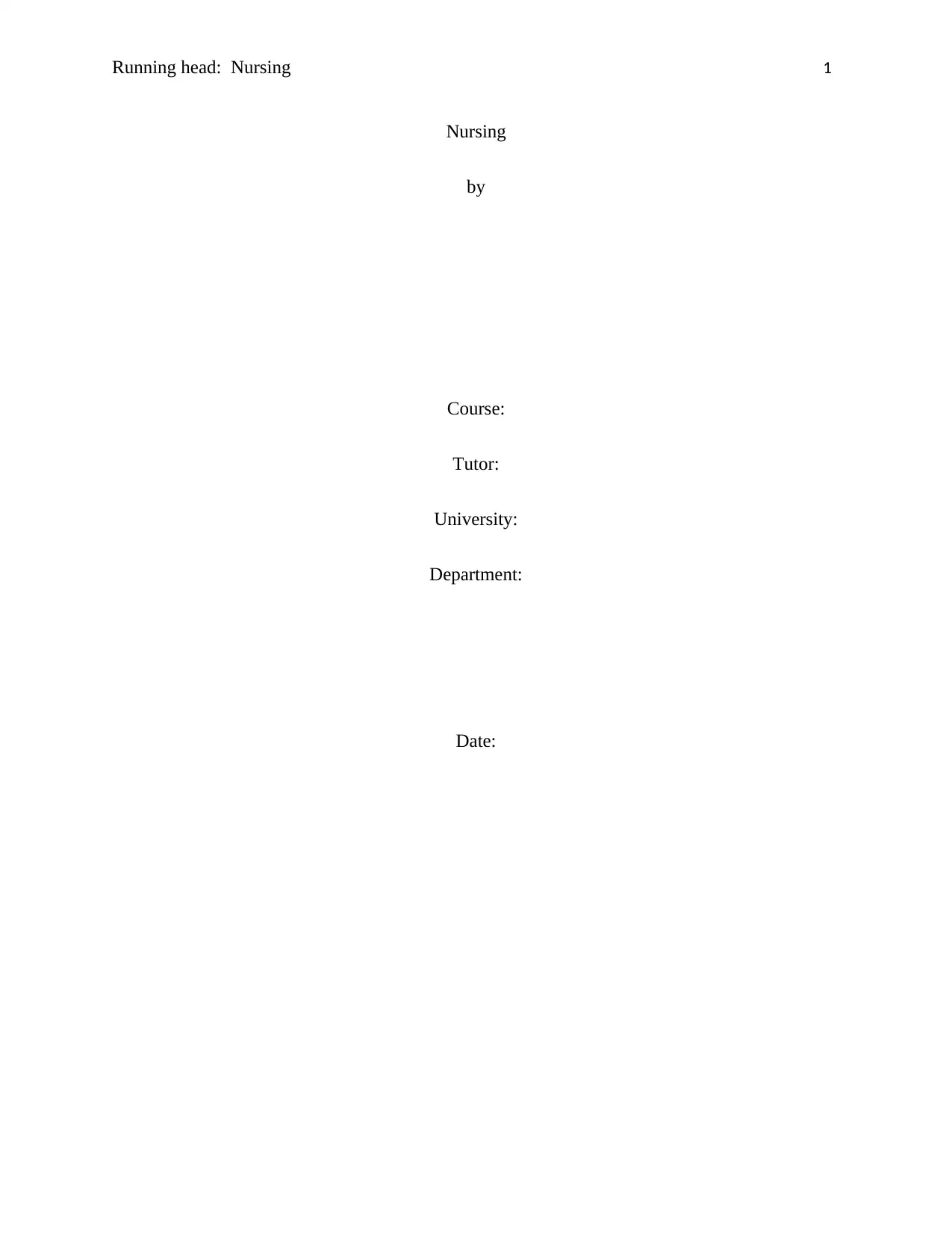
Running head: Nursing 1
Nursing
by
Course:
Tutor:
University:
Department:
Date:
Nursing
by
Course:
Tutor:
University:
Department:
Date:
Paraphrase This Document
Need a fresh take? Get an instant paraphrase of this document with our AI Paraphraser
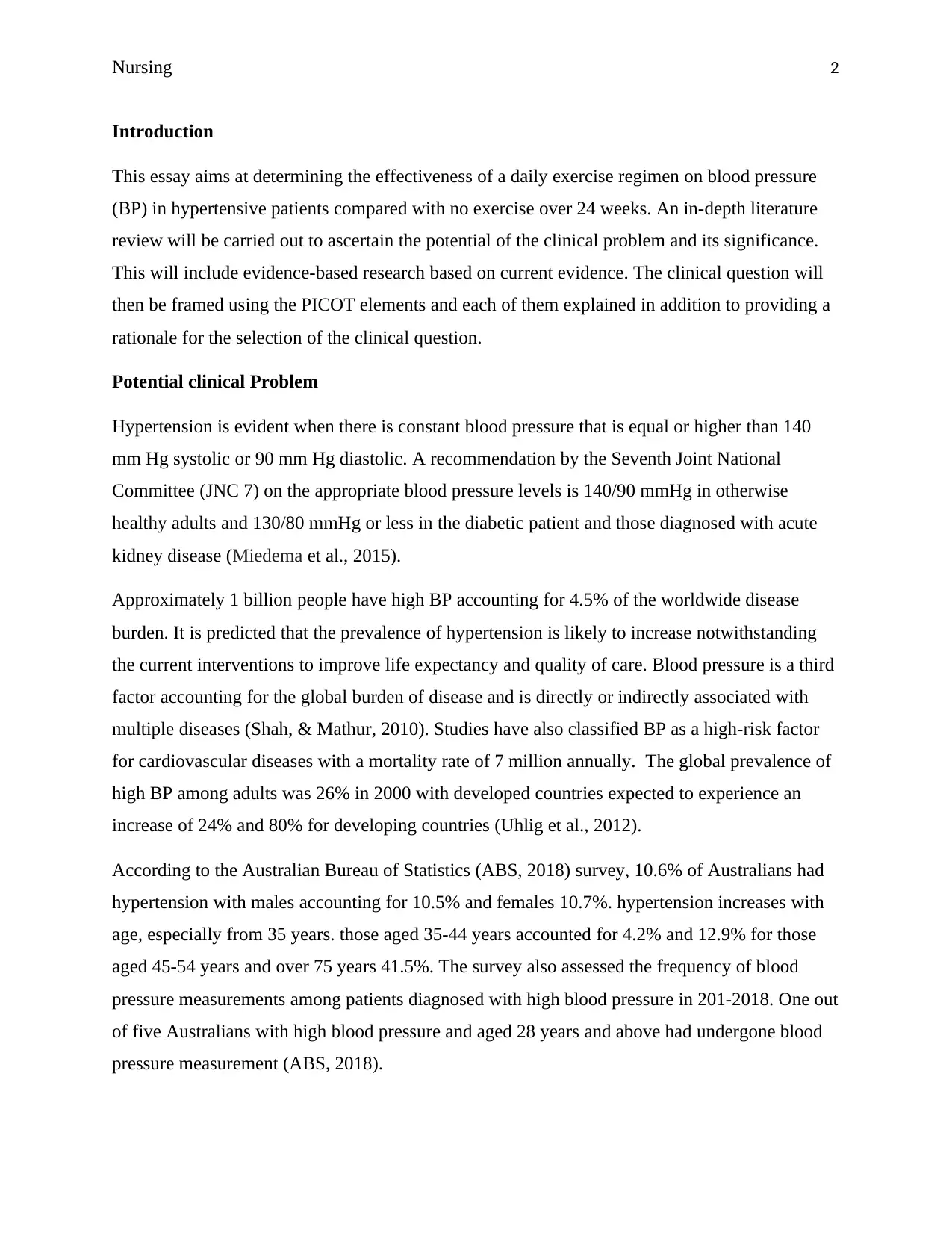
Nursing 2
Introduction
This essay aims at determining the effectiveness of a daily exercise regimen on blood pressure
(BP) in hypertensive patients compared with no exercise over 24 weeks. An in-depth literature
review will be carried out to ascertain the potential of the clinical problem and its significance.
This will include evidence-based research based on current evidence. The clinical question will
then be framed using the PICOT elements and each of them explained in addition to providing a
rationale for the selection of the clinical question.
Potential clinical Problem
Hypertension is evident when there is constant blood pressure that is equal or higher than 140
mm Hg systolic or 90 mm Hg diastolic. A recommendation by the Seventh Joint National
Committee (JNC 7) on the appropriate blood pressure levels is 140/90 mmHg in otherwise
healthy adults and 130/80 mmHg or less in the diabetic patient and those diagnosed with acute
kidney disease (Miedema et al., 2015).
Approximately 1 billion people have high BP accounting for 4.5% of the worldwide disease
burden. It is predicted that the prevalence of hypertension is likely to increase notwithstanding
the current interventions to improve life expectancy and quality of care. Blood pressure is a third
factor accounting for the global burden of disease and is directly or indirectly associated with
multiple diseases (Shah, & Mathur, 2010). Studies have also classified BP as a high-risk factor
for cardiovascular diseases with a mortality rate of 7 million annually. The global prevalence of
high BP among adults was 26% in 2000 with developed countries expected to experience an
increase of 24% and 80% for developing countries (Uhlig et al., 2012).
According to the Australian Bureau of Statistics (ABS, 2018) survey, 10.6% of Australians had
hypertension with males accounting for 10.5% and females 10.7%. hypertension increases with
age, especially from 35 years. those aged 35-44 years accounted for 4.2% and 12.9% for those
aged 45-54 years and over 75 years 41.5%. The survey also assessed the frequency of blood
pressure measurements among patients diagnosed with high blood pressure in 201-2018. One out
of five Australians with high blood pressure and aged 28 years and above had undergone blood
pressure measurement (ABS, 2018).
Introduction
This essay aims at determining the effectiveness of a daily exercise regimen on blood pressure
(BP) in hypertensive patients compared with no exercise over 24 weeks. An in-depth literature
review will be carried out to ascertain the potential of the clinical problem and its significance.
This will include evidence-based research based on current evidence. The clinical question will
then be framed using the PICOT elements and each of them explained in addition to providing a
rationale for the selection of the clinical question.
Potential clinical Problem
Hypertension is evident when there is constant blood pressure that is equal or higher than 140
mm Hg systolic or 90 mm Hg diastolic. A recommendation by the Seventh Joint National
Committee (JNC 7) on the appropriate blood pressure levels is 140/90 mmHg in otherwise
healthy adults and 130/80 mmHg or less in the diabetic patient and those diagnosed with acute
kidney disease (Miedema et al., 2015).
Approximately 1 billion people have high BP accounting for 4.5% of the worldwide disease
burden. It is predicted that the prevalence of hypertension is likely to increase notwithstanding
the current interventions to improve life expectancy and quality of care. Blood pressure is a third
factor accounting for the global burden of disease and is directly or indirectly associated with
multiple diseases (Shah, & Mathur, 2010). Studies have also classified BP as a high-risk factor
for cardiovascular diseases with a mortality rate of 7 million annually. The global prevalence of
high BP among adults was 26% in 2000 with developed countries expected to experience an
increase of 24% and 80% for developing countries (Uhlig et al., 2012).
According to the Australian Bureau of Statistics (ABS, 2018) survey, 10.6% of Australians had
hypertension with males accounting for 10.5% and females 10.7%. hypertension increases with
age, especially from 35 years. those aged 35-44 years accounted for 4.2% and 12.9% for those
aged 45-54 years and over 75 years 41.5%. The survey also assessed the frequency of blood
pressure measurements among patients diagnosed with high blood pressure in 201-2018. One out
of five Australians with high blood pressure and aged 28 years and above had undergone blood
pressure measurement (ABS, 2018).
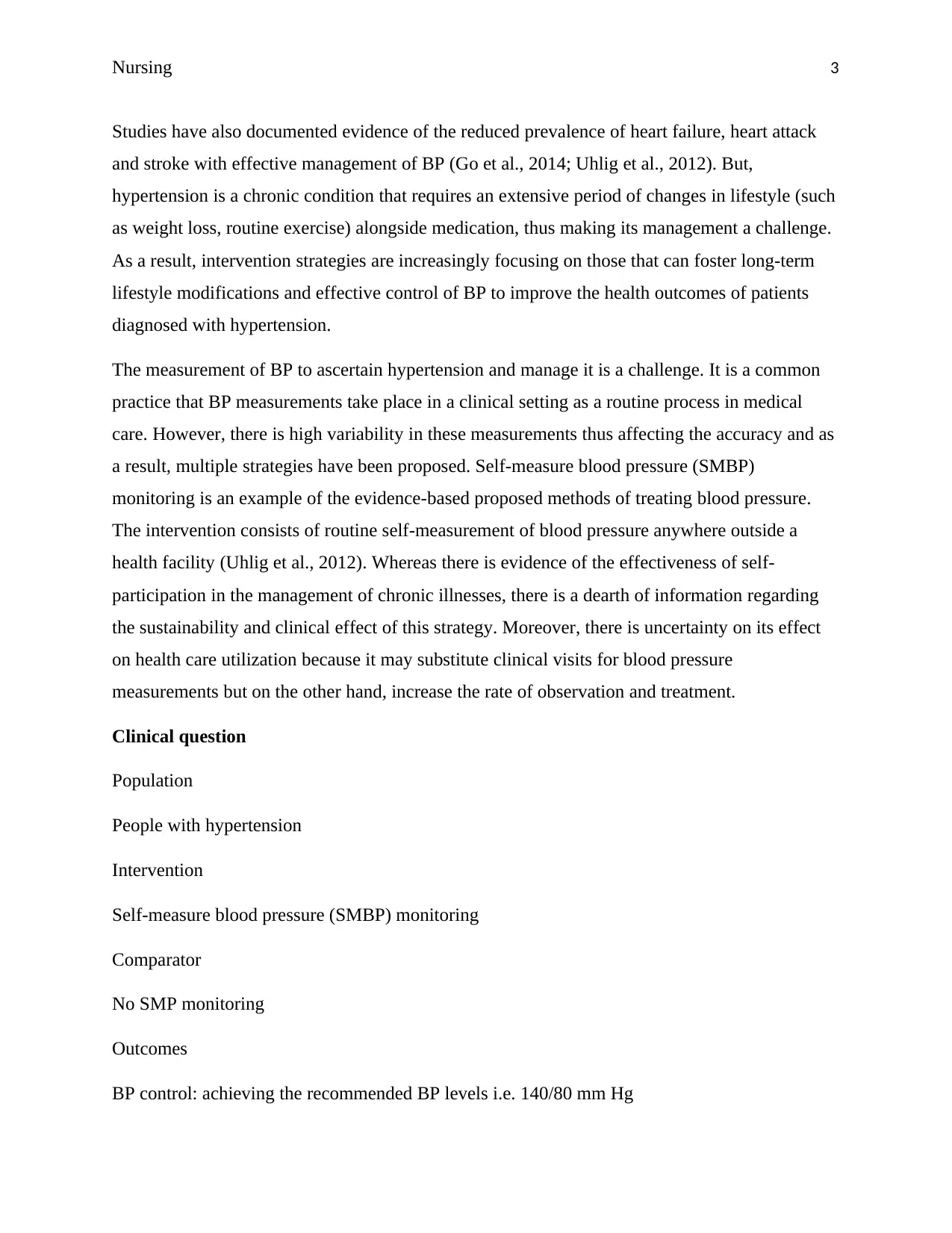
Nursing 3
Studies have also documented evidence of the reduced prevalence of heart failure, heart attack
and stroke with effective management of BP (Go et al., 2014; Uhlig et al., 2012). But,
hypertension is a chronic condition that requires an extensive period of changes in lifestyle (such
as weight loss, routine exercise) alongside medication, thus making its management a challenge.
As a result, intervention strategies are increasingly focusing on those that can foster long-term
lifestyle modifications and effective control of BP to improve the health outcomes of patients
diagnosed with hypertension.
The measurement of BP to ascertain hypertension and manage it is a challenge. It is a common
practice that BP measurements take place in a clinical setting as a routine process in medical
care. However, there is high variability in these measurements thus affecting the accuracy and as
a result, multiple strategies have been proposed. Self-measure blood pressure (SMBP)
monitoring is an example of the evidence-based proposed methods of treating blood pressure.
The intervention consists of routine self-measurement of blood pressure anywhere outside a
health facility (Uhlig et al., 2012). Whereas there is evidence of the effectiveness of self-
participation in the management of chronic illnesses, there is a dearth of information regarding
the sustainability and clinical effect of this strategy. Moreover, there is uncertainty on its effect
on health care utilization because it may substitute clinical visits for blood pressure
measurements but on the other hand, increase the rate of observation and treatment.
Clinical question
Population
People with hypertension
Intervention
Self-measure blood pressure (SMBP) monitoring
Comparator
No SMP monitoring
Outcomes
BP control: achieving the recommended BP levels i.e. 140/80 mm Hg
Studies have also documented evidence of the reduced prevalence of heart failure, heart attack
and stroke with effective management of BP (Go et al., 2014; Uhlig et al., 2012). But,
hypertension is a chronic condition that requires an extensive period of changes in lifestyle (such
as weight loss, routine exercise) alongside medication, thus making its management a challenge.
As a result, intervention strategies are increasingly focusing on those that can foster long-term
lifestyle modifications and effective control of BP to improve the health outcomes of patients
diagnosed with hypertension.
The measurement of BP to ascertain hypertension and manage it is a challenge. It is a common
practice that BP measurements take place in a clinical setting as a routine process in medical
care. However, there is high variability in these measurements thus affecting the accuracy and as
a result, multiple strategies have been proposed. Self-measure blood pressure (SMBP)
monitoring is an example of the evidence-based proposed methods of treating blood pressure.
The intervention consists of routine self-measurement of blood pressure anywhere outside a
health facility (Uhlig et al., 2012). Whereas there is evidence of the effectiveness of self-
participation in the management of chronic illnesses, there is a dearth of information regarding
the sustainability and clinical effect of this strategy. Moreover, there is uncertainty on its effect
on health care utilization because it may substitute clinical visits for blood pressure
measurements but on the other hand, increase the rate of observation and treatment.
Clinical question
Population
People with hypertension
Intervention
Self-measure blood pressure (SMBP) monitoring
Comparator
No SMP monitoring
Outcomes
BP control: achieving the recommended BP levels i.e. 140/80 mm Hg
⊘ This is a preview!⊘
Do you want full access?
Subscribe today to unlock all pages.

Trusted by 1+ million students worldwide
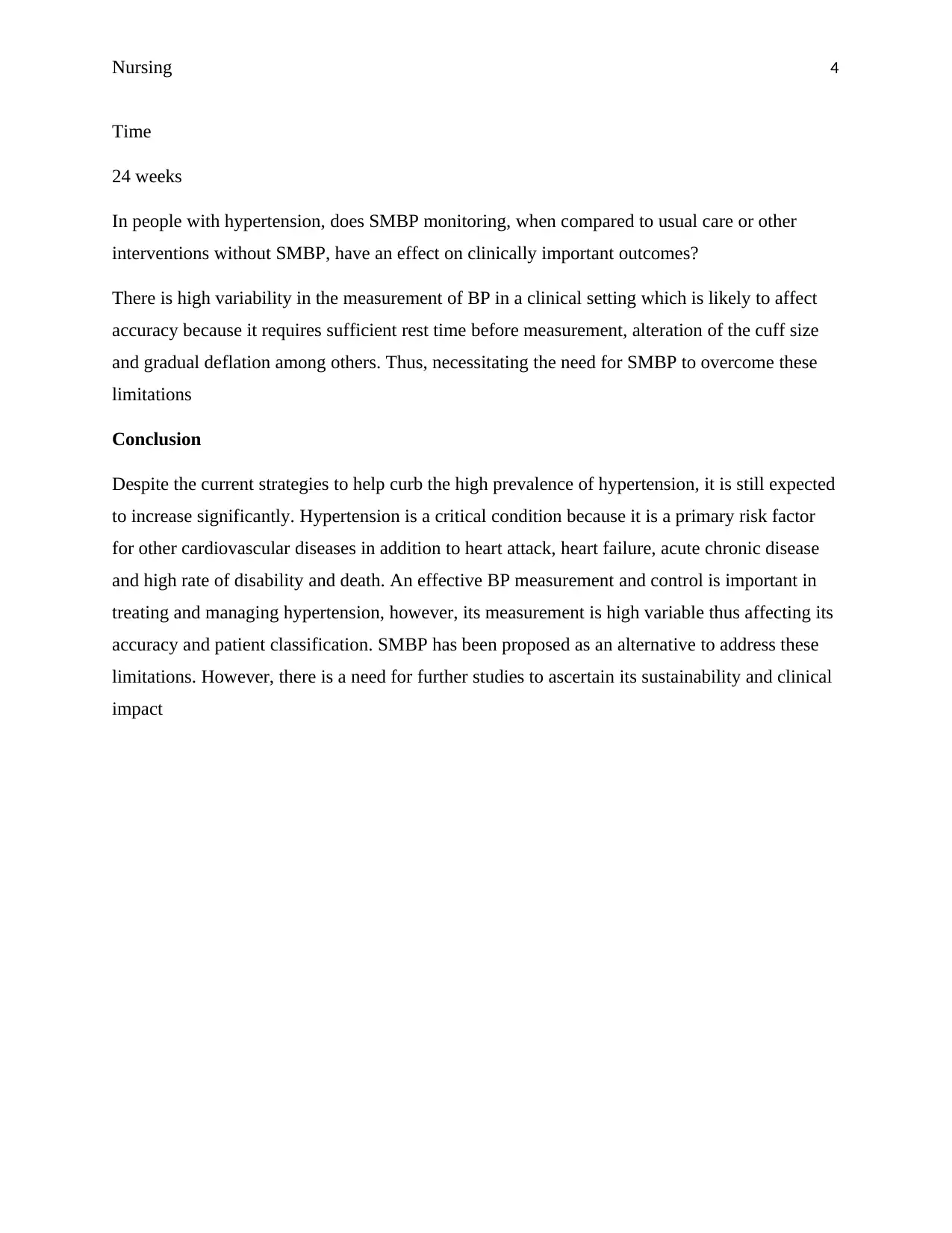
Nursing 4
Time
24 weeks
In people with hypertension, does SMBP monitoring, when compared to usual care or other
interventions without SMBP, have an effect on clinically important outcomes?
There is high variability in the measurement of BP in a clinical setting which is likely to affect
accuracy because it requires sufficient rest time before measurement, alteration of the cuff size
and gradual deflation among others. Thus, necessitating the need for SMBP to overcome these
limitations
Conclusion
Despite the current strategies to help curb the high prevalence of hypertension, it is still expected
to increase significantly. Hypertension is a critical condition because it is a primary risk factor
for other cardiovascular diseases in addition to heart attack, heart failure, acute chronic disease
and high rate of disability and death. An effective BP measurement and control is important in
treating and managing hypertension, however, its measurement is high variable thus affecting its
accuracy and patient classification. SMBP has been proposed as an alternative to address these
limitations. However, there is a need for further studies to ascertain its sustainability and clinical
impact
Time
24 weeks
In people with hypertension, does SMBP monitoring, when compared to usual care or other
interventions without SMBP, have an effect on clinically important outcomes?
There is high variability in the measurement of BP in a clinical setting which is likely to affect
accuracy because it requires sufficient rest time before measurement, alteration of the cuff size
and gradual deflation among others. Thus, necessitating the need for SMBP to overcome these
limitations
Conclusion
Despite the current strategies to help curb the high prevalence of hypertension, it is still expected
to increase significantly. Hypertension is a critical condition because it is a primary risk factor
for other cardiovascular diseases in addition to heart attack, heart failure, acute chronic disease
and high rate of disability and death. An effective BP measurement and control is important in
treating and managing hypertension, however, its measurement is high variable thus affecting its
accuracy and patient classification. SMBP has been proposed as an alternative to address these
limitations. However, there is a need for further studies to ascertain its sustainability and clinical
impact
Paraphrase This Document
Need a fresh take? Get an instant paraphrase of this document with our AI Paraphraser
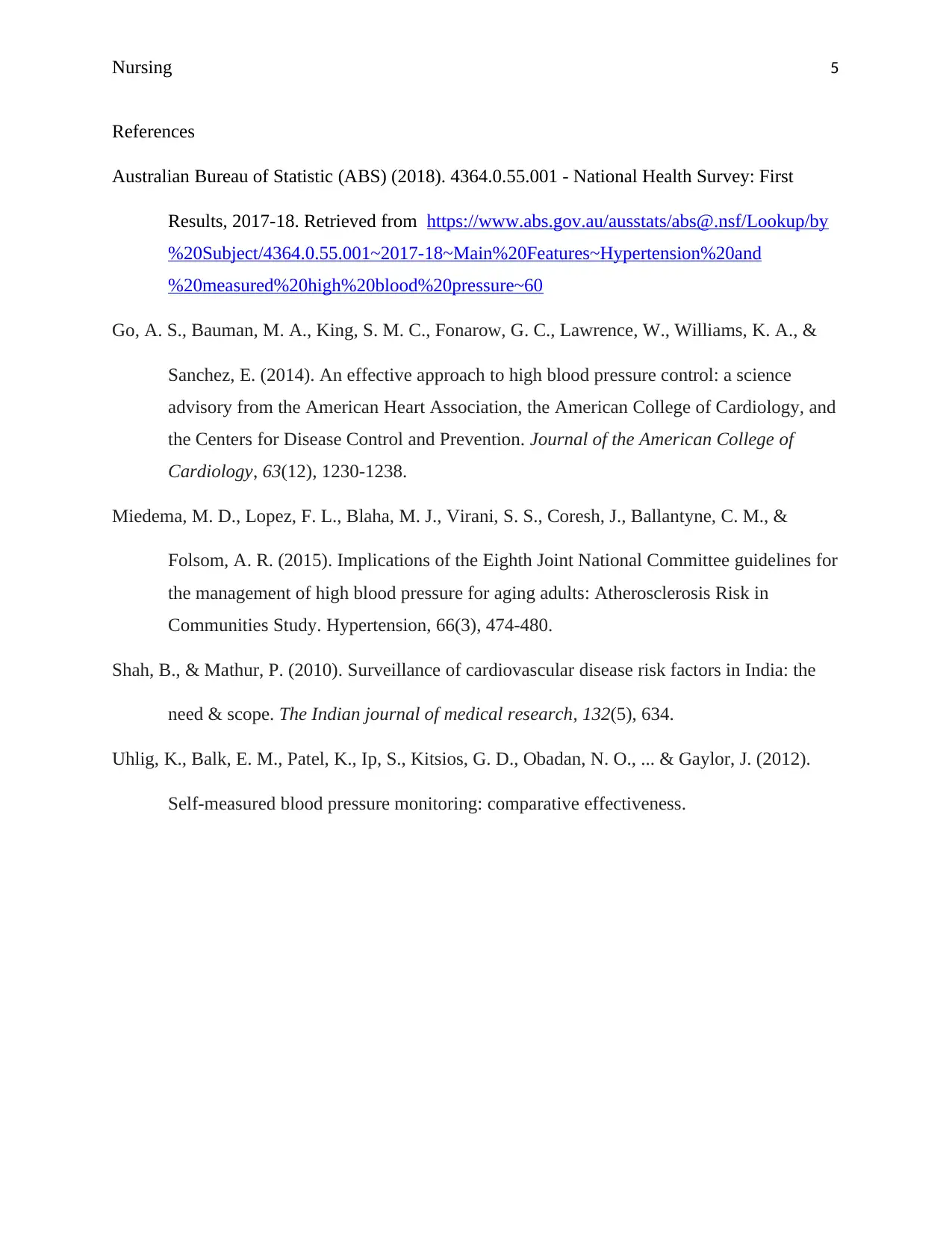
Nursing 5
References
Australian Bureau of Statistic (ABS) (2018). 4364.0.55.001 - National Health Survey: First
Results, 2017-18. Retrieved from https://www.abs.gov.au/ausstats/abs@.nsf/Lookup/by
%20Subject/4364.0.55.001~2017-18~Main%20Features~Hypertension%20and
%20measured%20high%20blood%20pressure~60
Go, A. S., Bauman, M. A., King, S. M. C., Fonarow, G. C., Lawrence, W., Williams, K. A., &
Sanchez, E. (2014). An effective approach to high blood pressure control: a science
advisory from the American Heart Association, the American College of Cardiology, and
the Centers for Disease Control and Prevention. Journal of the American College of
Cardiology, 63(12), 1230-1238.
Miedema, M. D., Lopez, F. L., Blaha, M. J., Virani, S. S., Coresh, J., Ballantyne, C. M., &
Folsom, A. R. (2015). Implications of the Eighth Joint National Committee guidelines for
the management of high blood pressure for aging adults: Atherosclerosis Risk in
Communities Study. Hypertension, 66(3), 474-480.
Shah, B., & Mathur, P. (2010). Surveillance of cardiovascular disease risk factors in India: the
need & scope. The Indian journal of medical research, 132(5), 634.
Uhlig, K., Balk, E. M., Patel, K., Ip, S., Kitsios, G. D., Obadan, N. O., ... & Gaylor, J. (2012).
Self-measured blood pressure monitoring: comparative effectiveness.
References
Australian Bureau of Statistic (ABS) (2018). 4364.0.55.001 - National Health Survey: First
Results, 2017-18. Retrieved from https://www.abs.gov.au/ausstats/abs@.nsf/Lookup/by
%20Subject/4364.0.55.001~2017-18~Main%20Features~Hypertension%20and
%20measured%20high%20blood%20pressure~60
Go, A. S., Bauman, M. A., King, S. M. C., Fonarow, G. C., Lawrence, W., Williams, K. A., &
Sanchez, E. (2014). An effective approach to high blood pressure control: a science
advisory from the American Heart Association, the American College of Cardiology, and
the Centers for Disease Control and Prevention. Journal of the American College of
Cardiology, 63(12), 1230-1238.
Miedema, M. D., Lopez, F. L., Blaha, M. J., Virani, S. S., Coresh, J., Ballantyne, C. M., &
Folsom, A. R. (2015). Implications of the Eighth Joint National Committee guidelines for
the management of high blood pressure for aging adults: Atherosclerosis Risk in
Communities Study. Hypertension, 66(3), 474-480.
Shah, B., & Mathur, P. (2010). Surveillance of cardiovascular disease risk factors in India: the
need & scope. The Indian journal of medical research, 132(5), 634.
Uhlig, K., Balk, E. M., Patel, K., Ip, S., Kitsios, G. D., Obadan, N. O., ... & Gaylor, J. (2012).
Self-measured blood pressure monitoring: comparative effectiveness.
1 out of 5
Related Documents
Your All-in-One AI-Powered Toolkit for Academic Success.
+13062052269
info@desklib.com
Available 24*7 on WhatsApp / Email
![[object Object]](/_next/static/media/star-bottom.7253800d.svg)
Unlock your academic potential
Copyright © 2020–2025 A2Z Services. All Rights Reserved. Developed and managed by ZUCOL.




